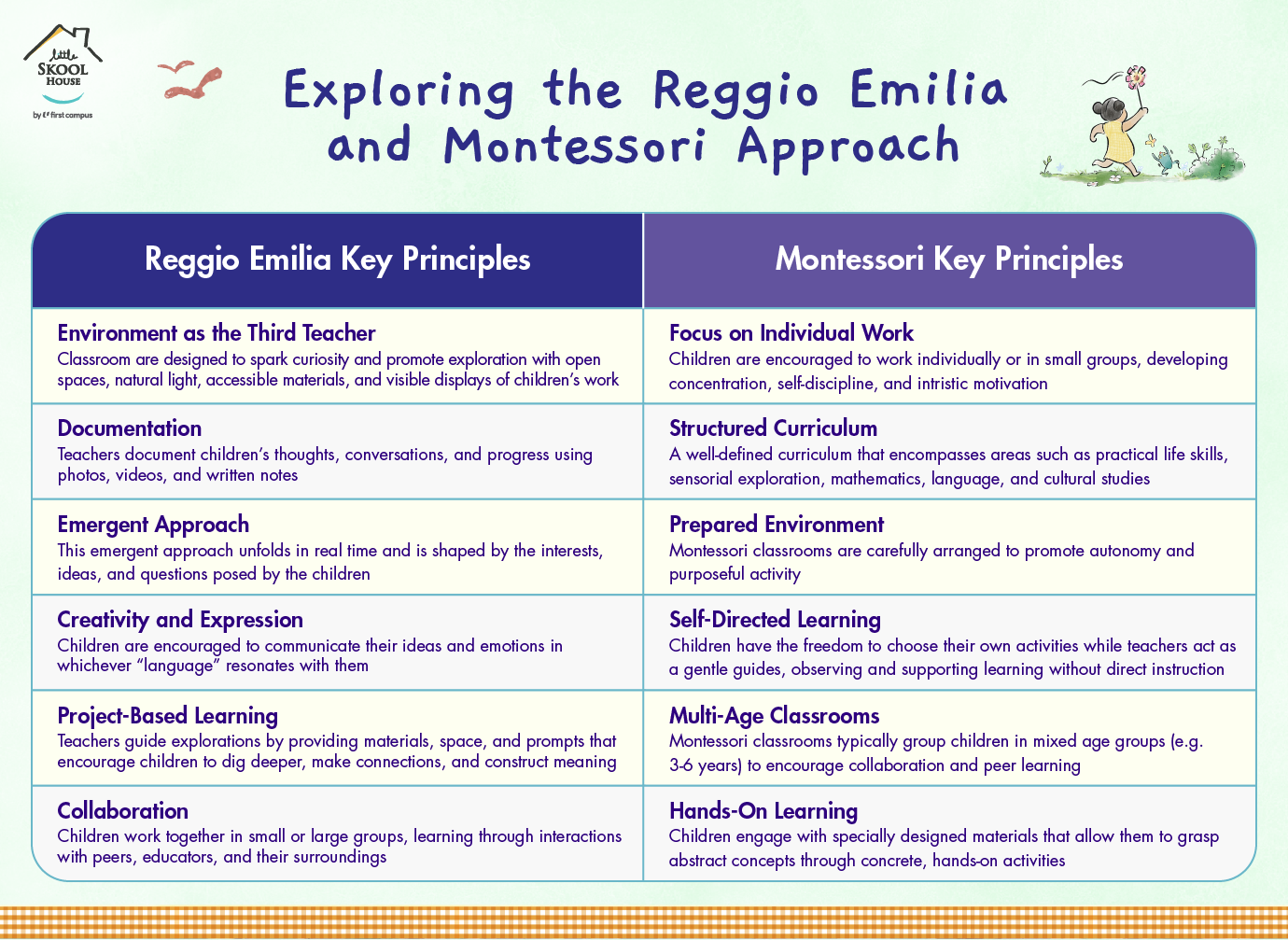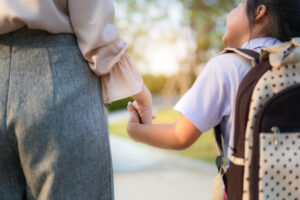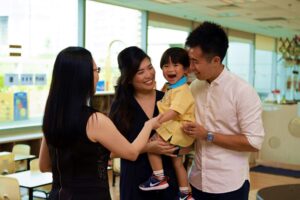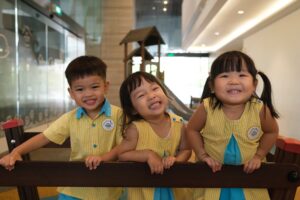BACK
When exploring early childhood education philosophies, the Montessori and Reggio Emilia approaches frequently emerge as prominent methodologies. Both emphasise child-centred learning but differ in principles and practices.
In Singapore’s highly competitive and academically driven early childhood landscape, many parents are looking beyond traditional preschools to find educational approaches that nurture both the heart and mind.
Two philosophies gaining attention are the Reggio Emilia and Montessori methods—each offering a stark contrast to rote-based systems and enrichment-heavy curriculums.
Whether you’re searching for specialised learning methods or simply looking for a preschool near you, understanding these philosophies can make decision-making easier.
While both approaches originated in Europe, their application in Singapore has taken on unique forms shaped by cultural expectations, bilingual education priorities, and the nation’s strong emphasis on school readiness. For parents weighing which path best suits their child, it’s helpful to understand how these approaches have been adapted—and how well they align with local values and educational goals.
This article delves into each approach, highlights their key differences, and introduces Little Skool-House as a commendable alternative in Singapore.
Key Differences Between Reggio Emilia and Montessori
Understanding the differences in educational strategies is crucial in the debate over Reggio Emilia vs. Montessori.
The Reggio Emilia approach emphasises child-led learning and flexibility, while Montessori focuses on structured, independent learning.
This comparative analysis, grounded in the Singaporean context, is designed to help parents evaluate which educational approach may be better suited for their child’s learning style and long-term development.
| Aspects | Reggio Emilia | Montessori |
|---|---|---|
| Adaptability to Singapore | More niche, often offered by boutique or premium preschools | Widely available across Singapore, with local adaptations for MOE alignment |
| Core Philosophy | Child-led, project-based learning rooted in collaboration and expression | Self-directed learning with structured, hands-on materials |
| Teacher’s Role | Co-researcher and facilitator | Observer and guide |
| Classroom Environment | Ever-evolving, aesthetically rich, often shaped by student projects | Calm, orderly, designed with specific learning materials for each concept |
| Curriculum Structure | Emergent and flexible, based on children’s interests | Structured progression through practical life, language, math, and culture |
| Academic Readiness | Less emphasis on academic drilling; learning through exploration | Strong focus on literacy, numeracy, and independence from early stages |
| Documentation & Assessment | Heavy use of portfolios and visual documentation of learning | Individual progress tracking through mastery of learning materials |
| Bilingual Integration | Depends on the preschool; not always a focus | Many Montessori preschools in Singapore integrate bilingual programmes well |
| Parental Involvement | High – parents often engaged in school life and projects | Moderate – more emphasis on the child’s independent learning journey |
| Cost & Accessibility | Often higher fees due to low teacher-child ratios and intensive documentation | Varies – many Montessori preschools offer more affordable options |
Exploring the Reggio Emilia Approach: Principles, Practices, and Classrooms in Singapore
Originating in post-World War II Italy, the Reggio Emilia approach was developed by educator Loris Malaguzzi and parents from the villages around Reggio Emilia to address the needs of children born into a society recovering from the war.
They aimed to create a new form of education that fostered respect, responsibility, and community through exploration and discovery in a supportive environment.
What does a Reggio Emilia classroom in Singapore look like?
In Singapore, Reggio Emilia-inspired classrooms are thoughtfully designed to foster exploration, creativity, and a deep connection with nature.
These environments often feature open spaces filled with natural light, incorporating elements like indoor plants and materials such as wood, leaves, and seeds to create an inviting atmosphere. This approach positions the environment as the “third teacher,” emphasising the importance of surroundings in a child’s development.
Key Principles
Environment as the Third Teacher
Reggio Emilia classrooms are designed to spark curiosity and promote exploration, with open spaces, natural light, accessible materials, and visible displays of children’s work.
Documentation
Teachers in Reggio Emilia settings act as researchers and co-learners. They meticulously document children’s thoughts, conversations, and progress using photos, videos, and written notes.
Emergent Curriculum
Rather than following a fixed syllabus, the Reggio Emilia curriculum employs an emergent approach, unfolding in real-time and shaped by the interests, ideas, and questions posed by the children.
Creativity and Expression
A hallmark of the Reggio Emilia philosophy is the Hundred Languages of Children—a metaphor for the countless ways children express themselves. Children are encouraged to communicate their ideas and emotions in whichever “language” resonates with them.
Project-Based Learning
At the core of the Reggio Emilia method is progettazione—long-term, child-initiated projects. Teachers guide these explorations by providing materials, space, and prompts that encourage children to dig deeper, make connections, and construct meaning.
Collaboration
Learning in a Reggio Emilia classroom is inherently social. Children work together in small or large groups, learning through interaction with peers, educators, and their surroundings.
Exploring the Montessori Approach: Principles, Practices, and Classrooms in Singapore
Developed by Dr. Maria Montessori, one of Italy’s first female physicians, the Montessori philosophy emphasises independence, hands-on learning, and a prepared environment. Dr. Montessori’s innovative techniques have educated generations of students worldwide.
What does a Montessori classroom in Singapore look like?
In Singapore, Montessori classrooms are thoughtfully designed to promote independence, self-directed learning, and hands-on experiences.
These environments typically feature child-sized furniture made from natural materials, such as wood, creating a calming and inviting atmosphere. Teachers act as guides, observing and supporting each child’s learning journey, fostering a love for knowledge and respect for diverse cultures.
Mixed-age groupings are common, allowing children to learn from and mentor each other, promoting social development and a sense of community.
Key Principles
Focus on Individual Work
Montessori places a strong emphasis on fostering independence through focused, independent work. Children are encouraged to work individually or in small groups, developing concentration, self-discipline, and intrinsic motivation.
Structured Curriculum
While children have freedom of choice, the Montessori method is grounded in a well-defined curriculum. It encompasses areas such as practical life skills, sensorial exploration, mathematics, language, and cultural studies.
Prepared Environment
Montessori classrooms are carefully arranged to promote autonomy and purposeful activity. The environment invites exploration, encourages responsibility, and fosters independence from an early age.
Self-Directed Learning
A defining feature of Montessori education is the emphasis on individualised learning, where children have the freedom to choose their own activities. Teachers act as gentle guides, observing and supporting learning without direct instruction.
Multi-Age Classrooms
Montessori classrooms typically group children in mixed age groups (e.g. 3–6 years). This setup encourages collaboration and peer learning, where younger children learn from older ones, and older children reinforce their knowledge by mentoring others.
Hands-On Learning
Learning in Montessori settings is tactile and experiential. Children engage with specially designed materials that allow them to grasp abstract concepts through concrete, hands-on activities.
Finding the Right Fit for Your Child

Both the Reggio Emilia and Montessori approaches offer enriching, child-centred environments that nurture independence, curiosity, and a love for learning. However, they are not without limitations.
The Reggio Emilia approach, while beautifully creative and responsive to children’s interests, can be highly dependent on educator expertise and is resource-intensive to execute well. It may also lack the academic structure some Singaporean parents expect—particularly when preparing children for the nation’s rigorous primary school system.
The Montessori method, on the other hand, offers more structure and a strong foundation in early literacy and numeracy. However, its highly individualised style may limit opportunities for group collaboration and creative expression. Additionally, strict adherence to Montessori materials can feel rigid, and the model may not always align seamlessly with local bilingual and academic expectations.
For parents who are seeking a balance between play-based learning, academic readiness, and cultural alignment, Little Skool-House presents a strong alternative.
For families who want the best of both worlds, it’s a preschool option worth serious consideration.
Little Skool-House: A Distinguished Alternative
As one of the premier premium preschools in Singapore, Little Skool-House is committed to nurturing confident, curious, and bilingual learners.
With its bilingual curriculum, research-backed pedagogy, and a strong emphasis on both expressive learning and academic outcomes, it reflects many of the strengths of both Reggio Emilia and Montessori—while being thoughtfully adapted to the realities of Singapore’s educational landscape.
The curriculum is grounded in decades of research from respected global institutions and has been specially designed to prepare children not only for a smooth transition into primary school—but also for a lifetime of inquiry, communication, and growth.
With a strong focus on language development, character-building, and well-rounded early education, Little Skool-House offers a distinctive path for parents who want both heart and rigour in their child’s early learning journey.
Choose from 20 Conveniently-Located Centres
Sources
- https://www.ais.com.sg/differences-between-reggio-emilia-montessori/
- https://www.lilyvalley.com.sg/reggio-emilia-vs-montessori-approach-which-is-better/



